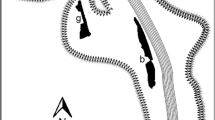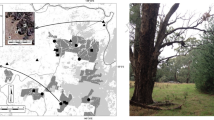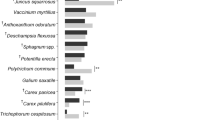Summary
This paper describes temporally varying determinants of the spatial distribution of adults in an insect population and the relationship between that distribution and the mating system. Male Oeneis chryxus butterflies were distributed nonrandomly throughout a sloping Colorado meadow divided horizontally by a dirt road into an upper and lower slope. Over an eight-year period of intensive study, the proportion of males located on the road, the upper slope, and the lower slope varied as a function of population size and sex ratio. In each year, more than half of the male population aggregated on sections of the road in a distinct and recurring pattern that was not correlated with the distribution of any food resource or thermal regime. Females were usually extremely scarce and not distributed in any pattern apparent from the few observations of them. Areas densely occupied by males were associated with visual landmarks. We hypothesize that the male distribution is determined by a pattern of movement of receptive females toward these landmarks. The road offers a thermally favorable environment with an unobstructed view in which to await the passage of scarce females. The mating system in this population has several lek-like features and supports the prediction that landmark mating is a favored strategy under conditions of female scarcity and wide dispersal of resources.
Similar content being viewed by others
References
Alcock J (1981) Lek territoriality in the tarantula hawk wasp Hemipepsis ustulata (Hymenoptera: Pompilidae). Behav Ecol Sociobiol 8:309–317
Alcock J (1983) Territoriality by hilltopping males of the great purple hairstreak, Atlides halesus (Lepidoptera: Lycaenidae): convergent evolution with a pompilid wasp. Behav Ecol Sociobiol 13:57–62
Alcock J (1985) Hilltopping in the Nymphalid butterfly Chlosyne californica (Lepidoptera). Am Mid Nat 113(1):69–75
Alcock J (1987) Leks and hilltopping in insects. J Nat Hist 21:319–328
Alcock J, O'Neill K (1987) Territory preferences and intensity of competition in the grey hairstreak Strymon melinus (Lepidoptera: Lycaenidae) and the tarantula hawk wasp Hemipepsis ustulata (Hymenoptera: Pompilidae). Am Mid Nat 118(1):128–138
Alexander RD (1961) Aggressiveness, territoriality, and sexual behavior in field crickets (Orthoptera: Gryllidae). Behavior 17:130–223
Alexander RD (1975) Natural selection and specialized chorusing behavior in acoustical insects. In: Pimentel D (ed) Insects, Science and Society. Academic Press, New York, p 284
Baker RR (1983) Insect territoriality. Ann Rev Entomol 28:65–89
Baughman JF, Murphy DD, Ehrlich PR (1988) Population structure in a hilltopping butterfly. Oecologia 75:593–600
Bernstein C (1980) Density-dependent changes in sex ratio in Colias lesbia (Lepidoptera: Pieridae). Ecol Ent 5:105–110
Bradbury JW (1977) Lek mating behavior in the hammer-headed bat. Z Tierpsych 45:225–255
Bradbury JW (1979) The evolution of leks. In: Alexander RD, Tinkle D (eds) Natural Selection and Social Behavior. Chiron Press
Bradbury JW (1985) Contrasts between insects and vertebrates in the evolution of male display, female choice, and lek mating. Hölldobler B, Lindauer M (eds) Exp Behav Ecol. Fischer, pp 273–289
Brown JL, Orians GH (1970) Spacing patterns in mobile animals. Ann Rev Ecol Syst 1:239–262
Buck J, Buck E (1976) Synchronous fireflies. Sci Am 234(5):74–85
Carpenter CR (1958) Territoriality: a review of concepts and problems. In: Roc A, Simpson GG (eds) Behavior and Evolution. Yale Univ Press, pp 224–250
Daily GC, Ehrlich PR (1991) A comparison of population structure and habitat selection in neighboring populations of the subalpine butterfly Oeneis chryxus (in press)
Davies NB (1978a) Ecological questions about territorial behavior. In: Krebs JR, Davies NB (eds) Behavioural Ecology: an Evolutionary Approach, Blackwell Press, pp 317–350
Davies NB (1978b) Territorial defence in the speckled wood butterfly (Parage aegeria): the resident always wins. Anim Behav 26:138–147
DeVries PJ (1978) Observations on the apparent lek behavior in Costa Rican rainforest Perrhybris pyrrha Cramer (Pieridae). J Res Lep 17(3):142–144
Edwards WH (1897) The Butterflies of North America (The Riverside Press, Cambridge), Third Series
Ehrlich PR (1984) The structure and dynamics of butterfly populations. In: Vane-Wright RI, Ackery PR (eds) The Biology of Butterflies. Academic Press, London, pp 25–40
Ehrlich AH, Ehrlich PR (1978) Reproductive strategies in butterflies. I. Mating frequency, plugging, and egg number. J Kansas ent Soc 51:666–697
Ehrlich PR, Wheye D (1986) “Nonadaptive” hilltopping behavior in male checkerspot butterflies (Euphydryas editha). Am Nat 127:477–483
Ehrlich PR, Wheye D (1988) Hilltopping checkerspot butterflies revisited. Am Nat 132(3):460–461
Ehrlich PR, White PR, Singer MC, McKechnie SW, Gilbert LE (1975) Checkerspot butterflies: a historical perspective. Science 188:221–228
Ehrlich PR, Launer AE, Murphy DD (1984) Can sex ratio be defined or determined? The case of a population of checkerspot butterflies. Am Nat 124(4):527–539
Eickwort G (1977) Male territorial behavior in the mason bee Hoplitis anthocopoides (Hymenoptera: Megachilidae). Anim Behav 25:542–554
Emlen ST, Oring LW (1977) Ecology, sexual selection, and the evolution of mating systems. Science 197:215–223
Gibson RM, Bradbury JW (1986) Male and female mating strategies on sage grouse leks. In: Rubenstein DI, Wrangham RW (eds) Ecological Aspects of Social Evolution. Princeton U Press, pp 379–398
Hölldobler B (1976) The behavioral ecology of mating in harvester ants (Hymenoptera: Formicidae: Pogonomyrmex). Behav Ecol Sociobiol 1:405–423
Hovanitz W (1940) Ecological color variation in a butterfly and the problem of “protective coloration”. Ecology 21(3):371–379
Jacobson M (1966) Chemical insect attractants and repellents. Ann Rev Entomol 11:403–422
Jolly GM (1965) Explicit estimates from capture-recapture data with both death and immigration — stochastic model. Biometrika 52:225–247
Kimsey LS (1980) The behavior of male orchid bees (Apidae, Hymenoptera, Insecta) and the question of leks. Anim Behav 28:996–1004
Knapton RW (1985) Lek strukture and territoriality in the chryxus arctic butterfly, Oeneis chryxus (Satyridae) Behav Ecol Sociobiol 17:389–395
Krebs JR, Harvey PH (1988) Lekking in Florence. Nature 333:12–13
Lederhouse RC (1982) Territorial defense and lek behaviour of the black swallowtail butterfly, Papilio polyxenes Behav Ecol Sociobiol 10:109–118
Lloyd JE (1973) Fireflies of melanesia: bioluminescence, mating behavior, and synchronous flashing (Coleoptera: Lampyridae). Environ Entomol 2:991–1008
Moore NW (1964) Intra- and inter-specific competition among dragonflies (Odonata) J Anim Ecol 33:49–71
Odendaal FJ, Iwasa Y, Ehrlich PR (1985) Duration of female availability and its effect on butterfly mating systems Am Nat 125:673–678
Odendaal FJ, Turchin P, Stermitz FR (1988) An incidental-effect hypothesis explaining aggregation of males in a population of Euphydryas anicia Am Nat 132 (5):735–749
Parker GA (1978) Evolution of competitive mate searching. Ann Rev Entomol 23:173–196
Parsons PA (1977) Lek behavïor in Drosophila (Hirtodrosophila) polypori Malloch — an Australian rainforest species. Evol 31:223–225
Pitelka FA (1959) Numbers, breeding schedule, and territoriality in pectoral sandpipers of northern Alaska. Condor 61:233–264
Rutowski RL, Alcock J, Carey M (1989) Hilltopping in the Pipevine Swallowtail Butterfly (Battus philenor). Ethology 82:244–254
Scott JA (1973) Convergence of population biology and adult behavior in two sympatric butterflies, Neominois ridingsii (Papilionoidea: Nymphalidae) and Amblyscirtes simius (Hesperioidea: Hesperiidae). J Anim Ecol 42:663–672
Scott JA (1986) The Butterflies of North America. Stanford Univ Press
Seber GAF (1965) A note on the multiple recapture census. Biometrika 52:249–259
Shields O (1967) Hilltopping. J Res Lepid 6:69–178
Singer MC, Wedlake P (1981) Capture does affect probability of recapture in a butterfly species. Ecol Ent 6:215–216
Spieth HT (1968) Evolutionary implications of sexual behavior in Drosophila Evol Biol 2:157–193
Spieth HT (1974) Courtship behavior in Drosophila Ann Rev Entomol 19:385–405
Thornhill R, Alcock J (1983) The Evolution of Insect Mating Systems. Harvard Univ Press, Cambridge, MA
Toft CA (1989a) Population structure and mating system of a desert bee fly (Lordotus pulchrissimus; Diptera: Bombyliidae). 1. Male demography and interactions. Oikos 54:345–358
Toft CA (1989b) Population structure and mating system of a desert bee fly (Lordotus pulchrissimus; Diptera: Bombyliidae). 2. Female demography, copulations and characteristics of swarm sites Oikos 54:359–369
Watt WB, Chew FS, Snyder LRG, Watt AG, Rothschild DE (1977) Population structure of pierid butterflies. I. Numbers and movements of some montane Colias species Oecologia 27:1–22
Wickman P, Wiklund C (1983) Territorial defense and its seasonal decline in the speckled wood butterfly (Pararge aegeria) Anim Behav 31:1206–1216
Willis MA, Birch MC (1982) Male lek formation and female calling in a population of the arctiid moth Estigmene acrea Science 218:168–170
Yeates D, Dodson G (1990) The mating system of a bee fly (Diptera: Bombyliidae). I. Non-resource-based hilltop territoriality and a resource-based alternative. J Insect Behav 3(5):603–611
Author information
Authors and Affiliations
Rights and permissions
About this article
Cite this article
Daily, G.C., Ehrlich, P.R. & Wheye, D. Determinants of spatial distribution in a population of the subalpine butterfly Oeneis chryxus . Oecologia 88, 587–596 (1991). https://doi.org/10.1007/BF00317724
Received:
Accepted:
Issue Date:
DOI: https://doi.org/10.1007/BF00317724




